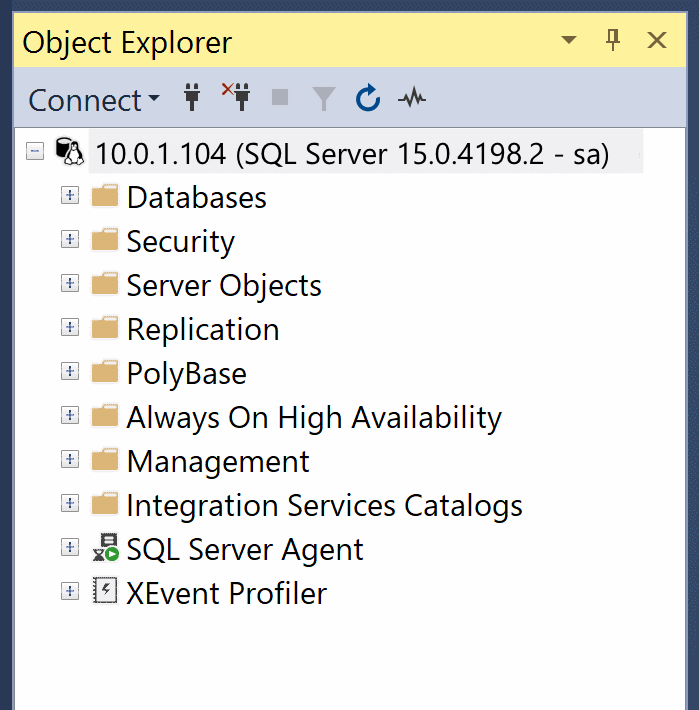Poznámka:
Přístup k této stránce vyžaduje autorizaci. Můžete se zkusit přihlásit nebo změnit adresáře.
Přístup k této stránce vyžaduje autorizaci. Můžete zkusit změnit adresáře.
Platí pro:SQL Server v Linuxu
Tento rychlý start vás provede postupem nasazení SQL Serveru v kontejnerech Linuxu do služby Azure Kubernetes Service (AKS) s grafy Helmz klientského počítače s Windows.
AKS je spravovaná služba Kubernetes pro nasazování a správu clusterů kontejnerů. Helm je opensourcový nástroj pro balení, který vám pomůže nainstalovat a spravovat životní cyklus aplikací Kubernetes.
Požadavky
Předplatné Azure. Pokud nemáte předplatné Azure, můžete si vytvořit bezplatný účet.
Stáhněte si a projděte si ukázkový Helm chart pro účely tohoto úvodu. Ukázkový graf obsahuje řadu možností konfigurace pro přizpůsobení nasazení SQL Serveru.
Instalace klientských nástrojů
Na klientském počítači s Windows potřebujete následující nástroje.
Pokud raději používáte jiný klientský operační systém, musíte vybrat vhodné balíčky pro danou platformu.
Instalace kubectl pomocí modulu Az PowerShell
K interakci s clusterem Kubernetes používáte kubectl. Další informace najdete v tématu az aks install-cli.
Pokud chcete nainstalovat kubectl, spusťte z příkazového řádku Windows následující příkaz:
az aks install-cli
Návod
Do místní proměnné prostředí můžete přidat PATH, takže nemusíte zadávat úplnou cestu pokaždé.
Připojení kubectl ke clusteru AKS
Je třeba sloučit kontext clusteru AKS, aby příkazy kubectl nebo helm se spouštěly v tomto konkrétním clusteru AKS.
Pokud chcete sloučit, spusťte příkaz popsaný v článku Připojení ke clusteru AKS.
az aks get-credentials --resource-group <resourcegroupname> --name <aks clustername>Měl by se zobrazit následující výstup, kde
<clustername>je cluster, který jste zadali, a<username>je místní uživatelský účet systému Windows:Merged "<clustername>" as current context in C:\Users\<username>\.kube.configSpuštěním
kubectl get nodespotvrďte, že sloučení proběhlo úspěšně. Výstup by měl zobrazit uzly v kontextu clusteru AKS.NAME STATUS ROLES AGE VERSION <aks-node>-vmss000000 Ready agent 141d v1.16.13 <aks-node>-vmss000001 Ready agent 141d v1.16.13
Kontrola ukázkového chartu Helm
Teď jste připraveni nasadit SQL Server v clusteru AKS prostřednictvím chartu Helm.
V tomto rychlém startu je k dispozici ukázkový "as-is" příklad "as-is" helm chart. Ukázka je určena pouze pro referenci. Nezapomeňte si projít readme soubor, abyste porozuměli hodnotám konfigurace, které odpovídají vašim požadavkům na konfiguraci.
Pokud chcete nasadit SQL Server v režimu StatefulSet, což je doporučený režim pro nasazení SQL Serveru, můžete se místo toho podívat na příklad nasazení Helm chartu založeného na StatefulSet "as-is".
V případě potřeby přepněte do adresáře, kam jste stáhli ukázkový graf, a v případě potřeby upravte soubor
values.yaml.
Nasazení SQL Serveru do clusteru AKS
K nasazení SQL Serveru použijte následující příkaz. Název nasazení je přizpůsobitelný, takže můžete změnit mssql-latest-deploy na cokoli, co chcete.
helm install mssql-latest-deploy . --set ACCEPT_EULA.value=Y --set MSSQL_PID.value=Developer
Když nasadíte kontejner pro SQL Server 2025 (17.x) nebo novější verzi, použijte MSSQL_PID=DeveloperStandard edici Standard Developer a MSSQL_PID=Developer edici Enterprise Developer.
V předchozím příkladu je graf a jeho soubory v aktuálním adresáři reprezentované tečkou (.). Pokud chcete, můžete určit cestu grafu.
V případě úspěchu se zobrazí podobný výstup:
NAME: mssql-latest-deploy
LAST DEPLOYED: Wed Apr 06 21:36:19 2022
NAMESPACE: default
STATUS: deployed
REVISION: 1
Ověření nasazení SQL Serveru
Nasazení do clusteru Kubernetes může trvat několik minut. Pokud chcete ověřit, že nasazení proběhlo úspěšně, spusťte následující příkaz:
kubectl get all
V případě úspěchu se zobrazí podobný výstup:
NAME READY STATUS RESTARTS AGE
pod/mssql-latest-deploy-7f8c7f5bc-9grmg 1/1 Running 0 2m56s
NAME TYPE CLUSTER-IP EXTERNAL-IP PORT(S) AGE
service/kubernetes ClusterIP 10.0.0.1 <none> 443/TCP 141d
service/mssql-latest-deploy LoadBalancer 10.0.247.220 20.40.0.145 1433:30780/TCP 2m56s
NAME READY UP-TO-DATE AVAILABLE AGE
deployment.apps/mssql-latest-deploy 1/1 1 1 2m56s
NAME DESIRED CURRENT READY AGE
replicaset.apps/mssql-latest-deploy-7f8c7f5bc 1 1 1 2m56s
Připojení k SQL Serveru spuštěného v AKS
K instanci SQL Serveru se můžete připojit pomocí libovolného známého klientského nástroje SQL Serveru, jako je sqlcmd, SQL Server Management Studio (SSMS) nebo rozšíření MSSQL pro Visual Studio Code.
Pokud se například připojíte k instanci SQL Serveru pomocí aplikace SSMS, můžete použít následující nastavení:
- název serveru : Použijte
External-IPadresu pro službumssql-latest-deploy. V tomto příkladu je to20.40.0.145. - Ověřování: Vyberte ověřování SQL Serveru z rozevíracího seznamu.
-
Přihlášení: Použít
sa, což je účet správce systému. -
Heslo: Heslo
saodpovídá hodnotě, kterou jste zadali v možnosti konfiguraceMSSQL_SA_PASSWORDv souboruvalues.yamlchartu Helm.
Po připojení můžete instanci SQL Serveru rozbalit v průzkumníku objektů .

Uklidit zdroje
Pokud už neplánujete dál používat váš AKS cluster, nezapomeňte odstranit svůj cluster.